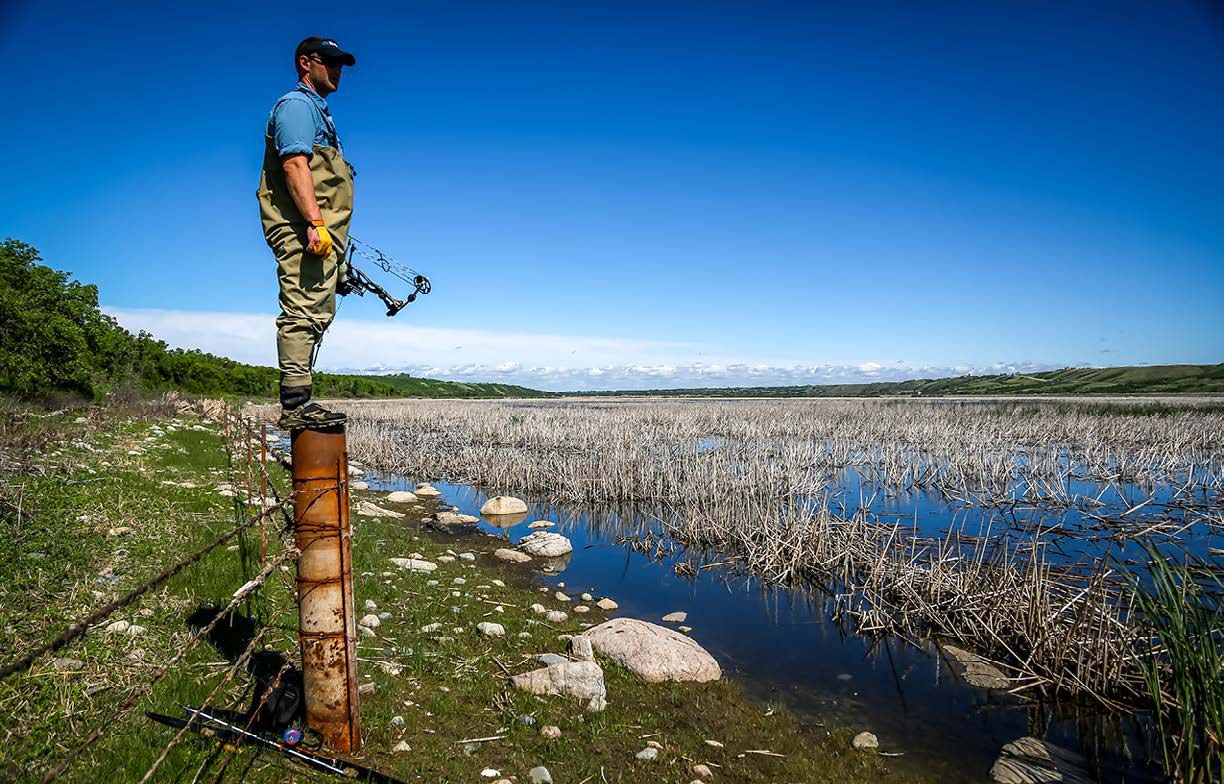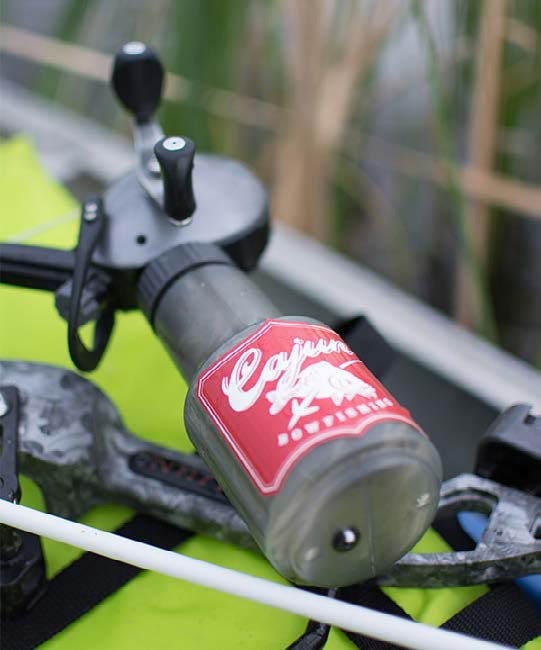It’s Fun in the Sun Going Shorts-And-Sandals Hunting for Giant Carp with a Bow and Arrow
Bowfishing combines fishing and hunting in one sport for some great summertime fun.
Much of the time, you’ll be wearing shorts and sandals–which isn’t a bad way to spend a summer afternoon.

Every June, I try to bowfish during the spawning season. With carp in shallow in many Saskatchewan lakes, it’s easy to spot, stalk, and shoot them. The ideal weather for bowfishing is hot and sunny, with little to no wind. Each year, I monitor the weather forecasts for my favorite lakes, and when the time looks good, I load the truck with gear and head east.
Despite being a capable bow fisherman, I’m still learning new locations, techniques, and shots each year. When I first started, I made many mistakes and I continue to miss fish each year. During the late spring and early summer, with the proper gear, conditions, and techniques, you can grapple a 20-pound carp, too.

Good Gear
Essential bowfishing gear consists of these six items: bow, reel, line, arrow, arrow tip, and arrow rest.
My bow was a Bear Archery Cajun Sucker Punch set to 45-pound draw without any let-off. I prefer quick snap shooting bows when bowfishing for carp because shooting opportunities materialize quickly as the fish swim into view.
My Sucker Punch was equipped with a bottle-fed reel to store the line. Bottle-style reels quickly crank in line, and they’re hassle-free when nocking another arrow for a shot. By comparison, a friend wanted to try bowfishing but had a spool. That setup just allows the line to come off when the arrow is released, and then it needs a manual respool afterward. Within an hour, and with no fish to show for it, he destroyed all his arrows, so I let him use my spare bow. I suggest that no matter what bow you use, be sure to get a bottle-fed reel that attaches to your bow. It’s the painless way to go.

Reels need to be outfitted with 50 meters of 80-pound (or more) test of super-braided, brightly colored line. Fiberglass arrows weigh- ing 1,200 to 1,500 grains provide an excellent penetrating punch to snare targeted fish. Bowfishing arrow tips need barbs, like fishhooks, so the arrow holds onto the fish once penetration occurs. This allows the angler to reel the fish in.
Securing the line to your arrow with a safety slide works well to keep the line in front of the riser, reducing entanglements and preventing dangerous “snap-back,” thus also reducing the chance of injury. The paying-out line stabilizes the solid fiberglass bare shaft arrow, making fletchings unnecessary since they could also misdirect a submerging arrow.

Arrow rests must be simple, durable, and strong enough to hold these heavy arrows. Unfortunately, Whisker biskets do not work well for good arrow flight. These fletchless arrows have a stopping point screwed into them near the rear to keep the safety slide from coming off.
Finally, always carry spare parts and spare arrows. On-person gear consists of polarized sunglasses. They’re a must for seeing fish underneath the water.
Good Technique
First and foremost, you need clear water visibility. You’ll often find clusters of carp swimming in a small pocket. Once you shoot a couple of them, and depending on the bottom conditions, things can get stirred up quickly, which also quickly reduces visibility. If that happens, it’s best to move to another location, perhaps even just 20 yards away. Then let things settle down before trying again.
I have shot fish from high above small boat platforms, in knee-deep water with waders, at the water’s edge onshore hidden in tall cattails, and most recently from a stable canoe. Every method has pros and cons, and they all work.

The big advantage of shooting from an elevated platform, like a boat, is the ability to move stealthily and to have a birds-eye perspective of swimming fish. However, it seems that carp can sense boat vibrations when they are swimming nearby or when they see your towering sky-lined figure. These shots are longer than ones where your feet are planted on the ground. The best opportunities come from nestling the boat along some cover and waiting patiently for fish to swim by. In this scenario, be sure to have the sun on your back and simply wait for the fish to swim into range. It’s essential to keep sudden movement to a minimum though and to wait for the fish to turn broadside before drawing. Otherwise, you will spook them.

Stalking from the ground prevents a skyline silhouette for fish to spot. However, because your eyes are closer to the water, it’s also harder to see fish. They tend to swim in closer to you, sometimes right through your feet. The best situation is to find a swim channel through thick weeds, blend yourself into the tall weeds nearby, and wait–which won’t be for long. I prefer the canoe because of its mobility, minimum draw, and set up
for two people to bow fish at once. One can fish from the bow and the other off the stern. Wedging a canoe into small weed islands in the marsh keeps the boat in place and provides some cover. Once you spot a swimming fish, simply draw slowly, anchor, and aim low.
|
|
|
|
|
|
|
|
|
About Aiming Low
As the sunlight travels from one medium (air) to another (water), it reflects (bends), giving a false image regarding where the fish appears to be as compared to its actual location.
The “apparent” fish will always appear higher than the actual fish target. For this reason, it’s important to aim low— but how low? That depends on the depth of the fish and how far away from you it is.
During this last trip, most of our fish were always situated two feet deep and 10 to 20 feet away. When fish were 10 feet away, aiming nine inches low worked well. At 20 feet away, 18 inches low worked well. Fish located less than one foot deep don’t need that much aim point compensation. Still, on these large, 20-pound carp, you must still aim low, pointing at just underneath the body.
In such situations, I have taken head-on shots, and they work well, assuming you’re able to draw your bow without spooking the fish. I like the head-on shots because your margin of error regarding high/low standing is increased over broadside shots. No matter what your angle, if you hit the fish between its head and dorsal fin, your arrow will stick—giving you a whole new appreciation for the term “fish on!”

Shoot and Repeat
Once a fish is on, do whatever you can to bring it in and get your arrow back. If the arrow hooked the tail, you’re in for great fight. Sometimes, you can use your reel directly to fight and bring in the fish. However, if the fish is aggressive, you’ll need hand-over-hand line retrieval– but watch the rope burn if they need line to run. Broadside shots through the belly and vertebrae are generally easier when fighting fish. The hardest part is dragging them in as they plow the water.
Once you put your hands on the fish, you need to get your arrow back. This can be tricky and “icky” in some situations. Going through bone in the vertebrae or head can be the most challenging area to get arrow tips back through. I’ve had to resort to unscrewing the tip and flipping the barb the other way to get my arrow back. You can do whatever works. Just make sure you wash and wipe your arrow clean, then ensure the tip is set tight again. The same tactic goes for missed shots when you bring in a clump of whatever is on the bottom. Remove the debris, rinse, wipe, and repeat.

The Day’s Catch
Bowfishing for carp is not catch-and-release, and while carp are not favored table fare, canning them can be an exception. That said, I’ve had a fish fry from past trips and we enjoyed an organic meal. Helping to manage these invasive fish by supplying pet food companies with your harvest goes a long way to boast a positive image for bowfishing. Personally, I use them for trapline bait to help control the wolf population.
Saskatchewan recently changed the regulation for bowfishing to make it illegal to waste your catch. Though the fish are still classified as invasive, they have been swimming in many water systems for 30-plus years. Still, shooting dozens of fish and leaving them to rot along the banks does not put forth a positive image for bowfishing or an ideal image of Saskatchewan. With a little thought and effort, pay your catch forward by helping another cause. This year, our 60-fish catch went to feeding pigs on a local farm.

Some Super Fun
Bowfishing is tons of fun. On an ideal day, you’ll release over 50 arrows at fish, likely connecting on more than half of the shots. In addition to bowfishing for carp, being in the environment surrounding marshes presents an abundance of songbirds, ducks, and geese. Their sounds and actions are incredible to watch.
Invasive carp are found throughout North America, so just ask around and you’ll find out where and when to go. After getting your gear and following the advice provided above, you’ll be well set up to have a great summer afternoon of bowfishing.

GEAR LIST
Bear Archery Cajun Bowfishing Bow
Bear Archery Cajun Bowfishing Arrow Tip
Bear Archery Cajun Bowfishing Arrows
Bear Archery Cajun Bowfishing Arrow Rest
Bear Archery Cajun Bowfishing Bottle Reel
Bear Archery Cajun Bowfishing Bowfishing Kit Costa Polarized Sunglasses
Per our affiliate disclosure, we may earn revenue from the products available on this page. To learn more about how we test gear, click here.











